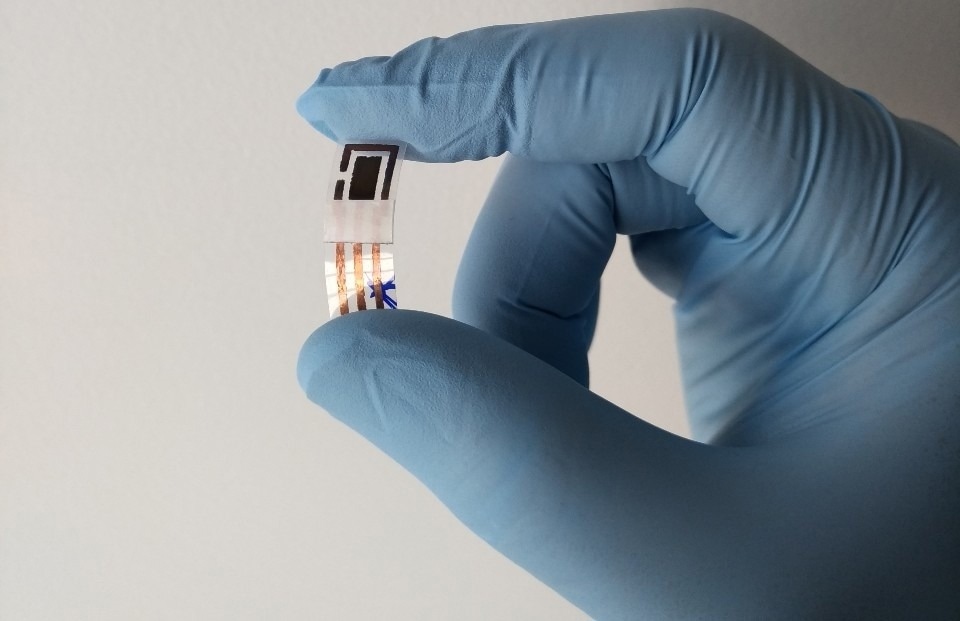
Flexible copper sensor made cheaply from ordinary materials: conductive copper adhesive tape, sheet of transparency film, paper label, nail varnish, circuit fabrication solution, and acetone (Image Credit: Anderson M. de Campos).
The existence of heavy metals like cadmium and lead are present in cosmetics, food, batteries, and other things that are a part of daily life. They are poisonous to humans, possibly resulting in numerous health issues; however, detecting them in bodily fluids requires expensive equipment and a regulated laboratory environment.
The study was financially supported by FAPESP (projects 16/01919-6 and 16/06612-6) and involved groups at the São Carlos Institutes of Physics (IFSC) and Chemistry (IQSC) as well as collaborators at the University of Munich in Germany and Chalmers University of Technology in Sweden.
The study outcomes are reported in an article in the Chemosensors journal.
We get important information on a person’s health by measuring their exposure to heavy metals. High levels of cadmium can lead to fatal problems in the airways, liver, and kidneys. Lead poisoning damages the central nervous system and causes irritability, cognitive impairment, fatigue, infertility, high blood pressure in adults and delayed growth and development in children.
Paulo Augusto Raymundo Pereira, Study Last Author and Researcher, IFSC Institute of Physics of São Carlos
Humans remove heavy metals primarily in urine and sweat. The analysis of such biofluids is an integral part of toxicological tests and treatment.
The world needs flexible sensors that are easily, cheaply and rapidly mass-produced, as our device is, for on-site detection, continuous monitoring, and decentralized analysis of hazardous compounds.
Paulo Augusto Raymundo Pereira, Study Last Author and Researcher, IFSC Institute of Physics of São Carlos
Contrary to other gold-standard tests performed to detect the existence of heavy metals in biofluids, the sensor is simple when it comes to the materials utilized to make it and the stages of its production.
The base of the device is polyethylene terephthalate [PET], on top of which is a conductive flexible copper adhesive tape, a label of the kind you can buy from a stationer’s, with the sensor printed on it, and a protective layer of nail varnish or spray. The exposed copper is removed by immersion in ferric chloride solution for 20 minutes, followed by washing in distilled water to promote the necessary corrosion. All this ensures speed, scalability, low power, and low cost.
Robson R. da Silva, Study Co-Author and Researcher, Chalmers University of Technology
The device has been linked to a potentiostat, a portable instrument that identifies the concentration of every metal by quantifying variations in potential and current between electrodes. The outcome is shown on a smartphone or computer utilizing suitable application software.
No training is required for any non-specialists or technicians in such locations as clinics, hospitals, and doctor’s offices, as the system is very simple to use. Also, the device could be utilized in numerous kinds of environmental management situations.
“Artesian wells, for example, are regulated and require constant monitoring to analyze water quality. Our sensor can be extremely useful in such cases,” stated Anderson M. de Campos, the first author of the article and a researcher at the University of Munich in Germany.
Refinements and a Possible Patent
The performance of the sensor in the detection of cadmium and lead was evaluated in trials with artificial sweat enriched under perfect experimental conditions. Adaptations are needed before the device can be patented.
“Until the invention was finalized, we found no reports of flexible copper sensors being used to detect toxic metals in sweat, but an anteriority search would probably turn up something similar, potentially blocking a patent application,” stated Marcelo L. Calegaro, the other co-author of the article and a researcher at IQSC-USP.
For this issue to be avoided, Calegaro is working on refinements and extra applications. One concept would involve substituting the corrosion stage, which generates waste, by cutting in a paper machine. One more would be to make use of the same type of device to detect pesticides present in food and water.
Journal Reference:
de Campos, A. M., et al. (2022) Design and Fabrication of Flexible Copper Sensor Decorated with Bismuth Micro/Nanodentrites to Detect Lead and Cadmium in Noninvasive Samples of Sweat. Chemosensors. doi.org/10.3390/chemosensors10110446.